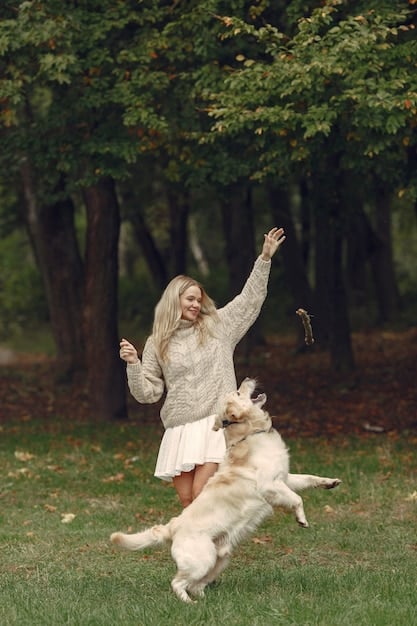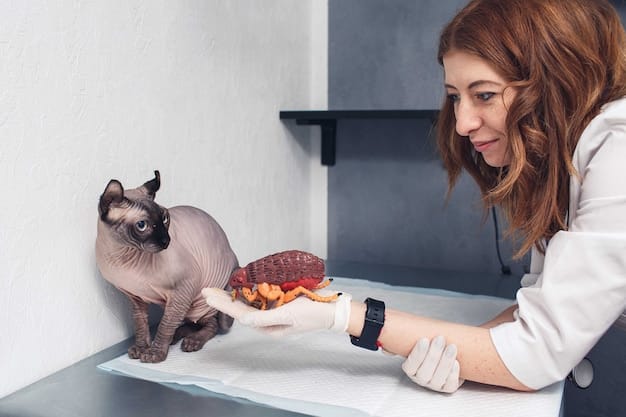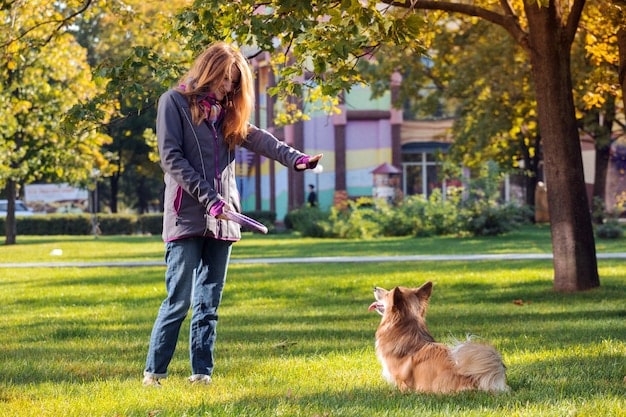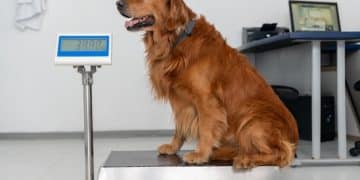Pet Obesity: Calculate Ideal Weight & Exercise Plan for a Healthy Pet

The pet obesity crisis demands immediate attention; calculating your pet’s ideal weight and establishing a tailored exercise plan are crucial steps towards ensuring their long-term health and well-being, combating the risks associated with excess weight.
The escalating **pet obesity crisis** is a growing concern for pet owners and veterinarians alike. Just like humans, pets can suffer from a range of health issues due to being overweight or obese. Understanding how to calculate your pet’s ideal weight and implementing a healthy exercise plan is crucial for their overall well-being and longevity. Let’s delve into how you can proactively address this issue and ensure your furry friend lives a happier, healthier life.
Understanding the Pet Obesity Crisis
The pet obesity crisis is a significant problem affecting a large portion of the pet population in the United States and worldwide. Overweight and obese pets are at a higher risk of developing various health complications that can drastically reduce their quality of life and lifespan. Identifying the root causes and understanding the scope of the issue is the first step towards effective management and prevention.
Prevalence of Pet Obesity
Studies show alarming rates of overweight and obese pets. According to recent surveys, a significant percentage of dogs and cats in the US are classified as overweight or obese. This prevalence rate highlights the urgency of addressing this issue through proactive measures and education.
Health Risks Associated with Obesity in Pets
Obesity in pets can lead to a multitude of health problems, mirroring many of the same health issues seen in obese humans. These conditions can range from metabolic disorders to joint problems, significantly impacting your pet’s well-being. Here are some critical conditions linked to obesity:
- Diabetes: Overweight pets are more prone to developing diabetes, which requires lifelong management and monitoring.
- Arthritis: Excess weight puts additional strain on joints, accelerating the development of arthritis and causing pain and mobility issues.
- Heart Disease: Obesity can lead to heart problems such as increased blood pressure and heart enlargement.
- Respiratory Issues: Overweight pets often suffer from breathing difficulties due to the extra weight around their chest and abdomen.
Addressing these risks requires not only a focused approach to weight management but also a deeper understanding of the underlying causes of pet obesity.

Calculating Your Pet’s Ideal Weight
Determining your pet’s ideal weight is a fundamental step in combating the pet obesity crisis. It provides a baseline for monitoring their health and setting realistic weight-loss goals. There are several methods you can use to assess your pet’s weight, including visual assessments, weight charts, and professional veterinary consultations.
Visual Assessment
A visual assessment involves observing your pet’s body condition to estimate if they are at a healthy weight. Look for the following signs:
Weight Charts and Body Condition Scores
Weight charts provide general guidelines based on breed and size, but the Body Condition Score (BCS) offers a more detailed assessment. The BCS is a scale, typically from 1 to 9, where 1 is emaciated, 5 is ideal, and 9 is obese. Veterinarians often use this scale to provide a standardized evaluation of a pet’s weight.
Consulting with your veterinarian is crucial for an accurate assessment. They can provide personalized advice and help you create a safe and effective weight management plan tailored to your pet’s specific needs.
Creating a Healthy Exercise Plan
Exercise is a cornerstone of any weight management program for pets. Regular physical activity helps burn calories, build muscle mass, and improve cardiovascular health. Crafting an effective exercise plan involves considering your pet’s breed, age, and current fitness level. Start slowly and gradually increase the intensity and duration of workouts to avoid injury and ensure your pet enjoys the process.
Tailoring Exercise to Your Pet’s Needs
Different pets have different exercise requirements. High-energy breeds like Border Collies and Huskies need significantly more exercise than low-energy breeds like Bulldogs or Persian cats. Consider the following factors:
- Breed: Research the typical exercise needs of your pet’s breed.
- Age: Puppies and kittens have different exercise limits compared to adult or senior pets.
- Health Conditions: Pets with arthritis, heart conditions, or other health issues may require modified exercise routines.

Types of Exercises for Pets
The types of exercises you incorporate into your pet’s routine should be varied and engaging to keep them motivated. Here are some ideas:
Always supervise your pet during exercise and provide plenty of water to keep them hydrated. Consulting with a vet or a certified pet fitness trainer can help you create a safe and effective exercise plan.
Nutrition and Diet Management
Proper nutrition is just as important as exercise when addressing the pet obesity crisis. Understanding your pet’s nutritional needs and making informed dietary choices can significantly contribute to their weight management efforts. This involves selecting the right type of food, controlling portion sizes, and limiting treats and snacks.
Choosing the Right Pet Food
The pet food market is vast, with numerous brands and formulations available. Selecting the right food requires careful consideration of your pet’s age, breed, activity level, and any specific health concerns. Look for foods that are:
- High in Protein: Essential for muscle maintenance and overall health.
- Moderate in Fat: Provides energy but should be balanced to avoid excess calorie intake.
- Low in Carbohydrates: Keeps blood sugar levels stable and reduces the risk of insulin resistance.
Portion Control and Feeding Schedules
Overfeeding is a common cause of pet obesity. Carefully measure your pet’s food according to the guidelines on the food packaging and adjust based on your vet’s recommendations. Establishing a consistent feeding schedule can also help regulate your pet’s metabolism and prevent overeating.
Avoid leaving food out all day, allowing your pet to graze. Instead, divide their daily food allowance into two or three meals.
The Role of Treats and Snacks
Treats can be a valuable tool for training and rewarding good behavior, but they should be given in moderation. Choose healthy, low-calorie treats and factor them into your pet’s total daily calorie intake. Avoid giving table scraps, as they are often high in fat and calories and can lead to weight gain.
Monitoring Progress and Adjusting the Plan
Regular monitoring is essential to ensure your pet is making progress towards their ideal weight. This involves tracking their weight, body condition, and overall health. Be prepared to adjust the exercise and diet plan as needed to achieve the desired results.
Regular Weigh-Ins and Body Condition Assessments
Weigh your pet regularly, preferably once a week, and record their weight. Also, conduct regular body condition assessments to monitor changes in their body shape and fat distribution. This will help you determine if the current plan is effective or if adjustments are needed.
Adjusting Exercise and Diet Based on Results
If your pet is not losing weight or showing improvements in their body condition, it may be necessary to adjust the exercise and diet plan. This could involve increasing the intensity or duration of exercise, reducing portion sizes, or switching to a different type of food. Always consult with your veterinarian before making significant changes to your pet’s routine.
Seeking Professional Guidance
Veterinarians and certified pet fitness trainers can provide valuable support and guidance throughout the weight management process. They can help you identify underlying health issues that may be contributing to obesity, develop a tailored plan, and monitor your pet’s progress. Don’t hesitate to seek professional assistance to ensure your pet’s safety and well-being.
Preventative Measures for Long-Term Health
Preventing weight regain is just as important as achieving weight loss. Implementing sustainable lifestyle changes and consistently monitoring your pet’s health will help them maintain a healthy weight in the long term. This involves continuing with the exercise and diet plan, providing regular veterinary check-ups, and remaining vigilant for any signs of weight gain.
Continuing Exercise and Diet Consistency
Maintain a consistent exercise routine and feeding schedule, even after your pet reaches their ideal weight. This will help them burn calories, maintain muscle mass, and regulate their metabolism. Avoid reverting to old habits that contributed to weight gain in the first place.
Regular Veterinary Check-Ups
Schedule regular veterinary check-ups to monitor your pet’s overall health and identify any potential issues early on. Your veterinarian can provide personalized advice on diet and exercise and help you address any underlying health concerns.
| Key Point | Brief Description |
|---|---|
| 🏋️ Exercise Plan | Tailor exercise based on breed, age, and health. Include walks, fetch, and swimming. |
| 🥗 Diet Management | Choose high-protein, moderate-fat, and low-carb food. Control portions and limit treats. |
| 🐾 Visual Assessment | Check for visible waistline and palpable ribs. Use Body Condition Score (BCS) for evaluation. |
| 🩺 Vet Guidance | Regular check-ups, personalized advice, and addressing health concerns with a vet. |
Frequently Asked Questions
Check for a visible waistline when viewed from above and easily palpable ribs. If you can’t feel the ribs without pressing or there’s no waistline, your pet may be overweight. Consult your vet for confirmation.
Pet obesity increases the risk of diabetes, arthritis, heart disease, respiratory problems, and reduced lifespan. It can significantly impact your pet’s quality of life and overall health.
The amount you feed your pet depends on their age, breed, activity level, and the food’s calorie content. Start with the guidelines on the food packaging and adjust based on your vet’s advice to avoid overfeeding.
Walking, running, playing fetch, and swimming are great exercises for dogs. Cats can benefit from interactive play with toys. Tailor the exercises to your pet’s breed, age, and health, gradually increasing intensity.
Weigh your pet weekly to monitor their progress. Track their weight and body condition to adjust the exercise and diet plan as needed. This helps maintain a healthy weight and prevent weight regain.
Conclusion
Addressing the pet obesity crisis requires a comprehensive approach that includes understanding the risks, calculating your pet’s ideal weight, creating a tailored exercise plan, and managing their nutrition. By taking these steps and seeking professional guidance when needed, you can help your pet live a happier, healthier, and longer life.





